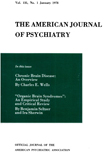THE DEVELOPMENT OF PLAY AS A FORM OF THERAPY: FROM ROUSSEAU TO ROGERS
Abstract
Psychoanalysis, while stimulating an interest in diagnosing and treating emotionally disturbed children, soon found its techniques and approaches had to be modified if they were to be used effectively with children. The child could not become an adult in order to be effectively psychoanalyzed. Consequently, the analyst had to go to the child. The importance of play and toys as an analytical tool was recognized. However, it was many years before successful analytic play techniques were established. A variety of active and passive forms of analytical play therapy continue to flourish.
Relationship therapy emphasized the present rather than the past, and stressed the importance of the dynamic relationship between the therapist and the patient. As a result, a method of child treatment soon developed from relationship therapy. The postulates of relationship therapy were rapidly absorbed into nondirective therapy. Nondirective beliefs place therapeutic reliance upon the person himself. Nondirective therapy was immediately useable as a form of play therapy. Its original postulates remain unchanged.
The development of play in child therapy was an inevitable process, for play therapy, no matter on which therapeutic theory it is based, provides the child with a natural avenue of approach to the therapist. He is enabled to calmly and without embarrassment reveal his ideas, emotions, wishes, attitudes, and fantasies to the therapist. Therapeutic play behavior enables the child to immediately release socially unacceptable impulses and aggressive behavior. He may discharge his feelings without fear of being censured or punished. Such a secure emotional discharge serves to quickly reduce the child's anxiety, enabling him to move safely on to therapeutic experiences.
Access content
To read the fulltext, please use one of the options below to sign in or purchase access.- Personal login
- Institutional Login
- Sign in via OpenAthens
- Register for access
-
Please login/register if you wish to pair your device and check access availability.
Not a subscriber?
PsychiatryOnline subscription options offer access to the DSM-5 library, books, journals, CME, and patient resources. This all-in-one virtual library provides psychiatrists and mental health professionals with key resources for diagnosis, treatment, research, and professional development.
Need more help? PsychiatryOnline Customer Service may be reached by emailing [email protected] or by calling 800-368-5777 (in the U.S.) or 703-907-7322 (outside the U.S.).



